For a truly extraordinary experience - go to Tasmania! The entire island only has a population of about 500,000. It has diverse and spectacular scenery, wilderness, wildlife, small historic towns, and so much more.
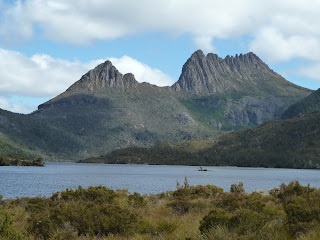
We arrived at Launceston airport, grabbed lunch in the historic town of Launceston - then headed over to Cradle Mountain National Park. We stayed in a cozy and cute log cabin, which even had a wood-burning heater. We walked around the popular Dove Lake - one of Tasmania's premier walks. It's a 6km track to walk around the lake.
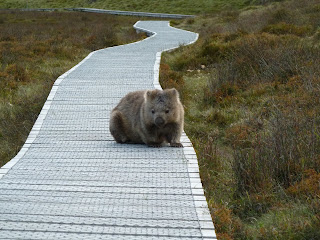
There were many boardwalk walking trails going through the National Park. At dusk, if you walk on the boardwalks you see tons of wildlife! We saw numerous wombats (pictured above), wallabies, & kangaroos. Actually, anywhere you drive at night in Tasmania, there are tons of animals out and about to see. But unfortunately because of the high population of wildlife in Tasmania, if you drive in the morning - there is a lot of roadkill on the road. :(

The next day, we drove from Cradle Mountain to the east coast of Tasmania. We stayed in the tiny seaside town of Swansea. This picture is of Oyster Bay, which is a sheltered bay that opens to the Tasman Sea.

The town of Bicheno, on the east coast of Tasmania, is home to over 600 fairy penguins! We went on a penguin tour, and were able to see the penguins up close in their natural environment. It was spectacular! And the history we learned about the penguins was quite interesting as well. In 1992, the penguin population was reduced to 40 birds because of feral cats and local dogs. Two men noticed the decline of the penguins and decided to purchase the land that the penguins inhabit, to protect them as best as they could. Today, more than 600 penguins inhabit the area. They swim all day, and then come to shore after dark to mate and feed & raise their young. We were able to see them walking from shore, resting along the way, nesting, and even quite a few baby penguins. It was an unforgettable experience!
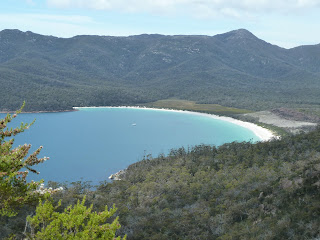
We spent an entire day in Freycinet National Park, on Tasmania's east coast. This park is known for its pink granite mountains, pure white beaches, coastal dunes, and dry forests. The park is most famous for the spectacular views of Wineglass Bay (pictured above). It's an all-day event to get to Wineglass Bay - you start by hiking up a mountain to this lookout point. Then you have to hike all the way down to the beach. It took us about 2.5 hours to arrive at the beach, and 2.5 hours to hike back to our car. But all of the walking was worth it - beautiful white sandy beaches and pure clear turquoise water!
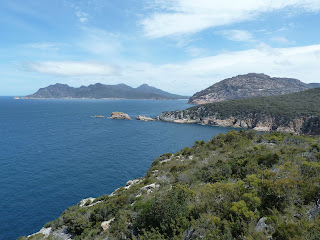
After all of the hiking to Wineglass Bay, we were ready for something easy and relaxing. So we headed over to the lighthouse, Cape Tourville, which overlooks the coast and Freycinet National Park. It had amazing coastal views! We read that during peak seasons, you can even see whales from this lookout.

After staying on the east coast of Tasmania for a couple of days, we headed down to finish our vacation in the town of Hobart. Hobart is the state capital and most populous city of the island. It was gorgeous - surrounded by water, historic areas, old cottages and churches, etc. We stayed in a historic home which had been converted into a bed and breakfast. On our first day, we went to a wildlife park to see Tasmanian Devils. They weren't at all what we were expecting to see - they looked like small dogs. The story of the Tasmania Devil is actually quite tragic. When European settlers arrived in Tasmania, they were scared of the animal's loud screeches, black color, and bad temper - so they named it the Tasmanian Devil and set out to kill it. For more than a century, devils were trapped and poisoned. They became very rare, and were heading towards extinction. After a law was passed in 1941 to protect the devils, their population slowly began to rise. Unfortunately today, even though they are protected, there is a devastating disease sweeping through the devil population in Tasmania. They are calling it a cancer of the mouth, and it is passed through touch. Just like humans shake hands, Tasmanian devils greet each other by mouth-to-mouth contact.... which is unfortunate for the devil, because it is killing them. Our guide said that it's being predicted that the entire population may become extinct in a short time if nothing is done to cure this deadly cancer. :( Another interesting fact about devils: they are born the size of a grain of rice and then stay in their mother's pouch for about 4 months. They are truly remarkable animals! We feel very fortunate to have been able to see them and learn about them. We hope that something will be done to help these poor animals survive.
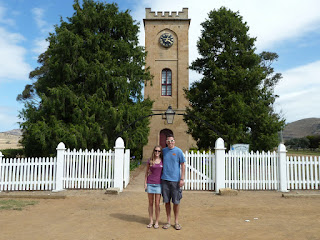
Next we headed over to the historic picture-perfect town of Richmond. It was like stepping back in time to see a truly old town with traditional homes, cottages, and churches. The homes have mostly been turned into restaurants and shops, but they were still beautiful.

Australia's oldest bridge is in Richmond, built by convict labor between 1823 and 1825.
This post wraps up our 3 week vacation of Australia & Tasmania! Next I will do a short FAQ page to answer a few of the common questions about the country and our trip.
 The town of Bicheno, on the east coast of Tasmania, is home to over 600 fairy penguins! We went on a penguin tour, and were able to see the penguins up close in their natural environment. It was spectacular! And the history we learned about the penguins was quite interesting as well. In 1992, the penguin population was reduced to 40 birds because of feral cats and local dogs. Two men noticed the decline of the penguins and decided to purchase the land that the penguins inhabit, to protect them as best as they could. Today, more than 600 penguins inhabit the area. They swim all day, and then come to shore after dark to mate and feed & raise their young. We were able to see them walking from shore, resting along the way, nesting, and even quite a few baby penguins. It was an unforgettable experience!
The town of Bicheno, on the east coast of Tasmania, is home to over 600 fairy penguins! We went on a penguin tour, and were able to see the penguins up close in their natural environment. It was spectacular! And the history we learned about the penguins was quite interesting as well. In 1992, the penguin population was reduced to 40 birds because of feral cats and local dogs. Two men noticed the decline of the penguins and decided to purchase the land that the penguins inhabit, to protect them as best as they could. Today, more than 600 penguins inhabit the area. They swim all day, and then come to shore after dark to mate and feed & raise their young. We were able to see them walking from shore, resting along the way, nesting, and even quite a few baby penguins. It was an unforgettable experience!
The narrative you've provided about Tasmania is very interesting. I may look into supporting the research of the Tasmanian Devil. I thought it was so interesting that the oldest bridge/viaduct in Australia was built by convicts--did you take that wonderful picture?!
ReplyDeleteLOVE that two men have saved the fairy penguins - very cool that they have thrived so well.
ReplyDeleteSAD to hear about the tasmanian devils - crazy to think they could go extinct =(
Yes I did take that picture of the bridge! I even have it in black & white - turned out pretty awesome! I think I'm going to frame it!
ReplyDelete